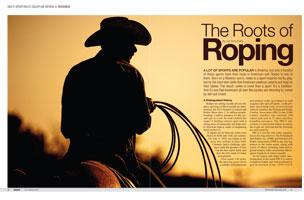
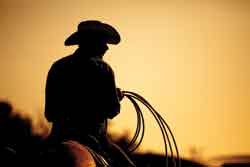 A lot of sports are popular in America, but only a handful of those sports have their roots in American soil. Rodeo is one of them. Born on a Western ranch, rodeo is a sport inspired not by play, but by the hard-won skills that American cowboys used to put food on their tables. The result: rodeo is more than a sport. It's a tradition. And it's one that Americans all over the country are returning to, crowd by sell-out crowd.
A lot of sports are popular in America, but only a handful of those sports have their roots in American soil. Rodeo is one of them. Born on a Western ranch, rodeo is a sport inspired not by play, but by the hard-won skills that American cowboys used to put food on their tables. The result: rodeo is more than a sport. It's a tradition. And it's one that Americans all over the country are returning to, crowd by sell-out crowd.
A Distinguished History
Rodeos are setting records all over the place, and some of those records are astronomical: the 2011 Houston Livestock and Rodeo Show drew 2.26 million people, breaking 2 million attendees for the second year in a row. So what's behind the surge? A thrilling extreme sport with a strong sense of community and deep roots in American history, rodeo is recapturing hearts in the U.S.
If legend can be believed, rodeo even shares its birth date with our country. On July 4, 1869, according to the story, two cowboys in Deer Trail, Colorado, held a challenge, aiming to settle the question of who was the best ranch hand, and thus the first seeds of rodeo were planted.
Over nearly 150 years, the sport has given rise to a number of professional and amateur rodeo associations as well as quite a few spin-off sports. As the premier sanctioning body of professional rodeo in America, the Professional Rodeo Cowboy Association (PRCA) has 8,000 cowboy members and sanctions 600 rodeos each year in 37 states and three Canadian provinces. The PRCA also oversees its sanctioned rodeos to ensure the events are well-run and the livestock are well cared for.
PRCA is not the only rodeo organization in the ring, however. The Professional Bull Riders, Inc. (PBR) and Women's Pro Rodeo Association (WPRA) are also key players in the rodeo scene, along with scores of others, including state and regional amateur rodeo associations that organize hundreds of rodeos annually.
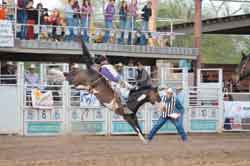 |
| Photo courtesy of Siri Stevens, Rodeo News |
As the largest and oldest rodeo sanctioning body in the world, PRCA is rodeo's recognized leader and well-positioned to give an overview of the sport's status. According to the PRCA, professional rodeo attracts about 30 million fans each year, with televised pro rodeo circuit events keeping the excitement high.
The Amateur Angle
The PRCA sanctions a number of series and events, including the All American ProRodeo Series and the Dodge Circuit, which enables weekend cowboys to compete locally and regionally while still collecting points to earn places at regional and national competitions. After all, many cowboys, even professionals, have day jobs and families, making it difficult to travel constantly.
"In Nebraska, there's actually more amateur rodeos than pro rodeos," says Chad Johnston, president of the Nebraska State Rodeo Association. "The amateur association has been around just as long as the PRCA, and we've established strong relationships with contestants, spectators, rodeo committees and stock contractors."
In recent years, amateur rodeos actually have been strengthened by the challenging economic climate. The community rodeo provides an affordable family event, but also because fewer cowboys can stay on the road full-time, amateur rodeos have cowboys of the highest caliber.
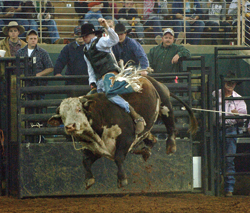 |
| Photo courtesy of Andrew Sullivan |
The Nebraska State Rodeo Association, formed in 1955, has approximately 300 amateur members and sanctions more than 60 rodeos annually, many of which are integral parts of the state's festivals and fairs.
Part of the appeal of the rodeo is its family-friendly atmosphere. "You don't have to worry about people using bad language," says Johnston. "And if someone does throw a fit in the arena, we can and will fine them."
But Siri Stevens, publisher of Rodeo News, believes that rodeo's appeal goes even deeper.
"I brought in a team roper to visit my nephew's fourth grade class," says Stevens. "During the demonstration, a fifth grade class filed by, and I heard a kid say, ‘There's a real live cowboy in the library.' I think that's what's bringing more and more people to the rodeo. Things have been unstable and people are looking to get back to their roots. It's tradition."
Roots & Boots
Another new event in Queen Creek, Arizona, offers further evidence of rodeo's rising star. The Roots & Boots Pro Rodeo made an impressive debut this March, drawing a crowd of more than 8,000 spectators throughout the two-day event, which celebrated the history and culture of Queen Creek. The entire town came together to produce the rodeo.
"The rodeo was a huge success. We have over 3,200 seats in our main arena, and they were packed full," says Tim Lynch, general manager, Horseshoe Park & Equestrian Centre. "In addition, during the summer, we've got a program called Friday Night Lights. Summer days in Arizona are hot, so this is a good way to get out and enjoy the beautiful evenings."
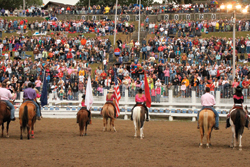 |
| Photo courtesy of Dayton Rodeo |
Friday Night Lights is a weekly event that brings families to the Park for food, vendors and events, including team roping, barrel racing, pole bending and junior bull riding.
Horseshoe Park may be a new facility, but as far as rodeo is concerned, they're also a stacked team. General manager Lynch spent eight years as a PRCA rodeo clown and his executive assistant, Tammy Kelly, is a six-time champion bull rider. Events at Horseshoe Park also enjoy the enthusiasm of the Arizona crowds.
"I came out from Oklahoma, and I always thought of it as a rodeo state," says Lynch. "But it doesn't even compare to Arizona. People here just go crazy for rodeo."
Montana's Rodeo Scene
Bozeman, Montana, is a city that promises an adventure for everyone. Tucked along the Rocky Mountains, Bozeman offers outdoor recreation, dinosaur hunting, blue ribbon fishing, geysers and, of course, rodeo.
Rumored to have some of Montana's best riders, Bozeman is a true rodeo town. It's also host of the State High School Rodeo Finals, an event that pits the best 350 participants against the best stock for an action-packed rodeo. The event actually consists of six rodeos, which narrow the field of competitors to the best 16, who battle it out in the year-end finals rodeo.
The State High School Rodeo Finals are held at the Gallatin County Fairgrounds, a multipurpose venue that, since 1903, has been home to many of Bozeman's classic sports and entertainment events, including the Bozeman Roundup, Gallatin County Fair, and the Wild West WinterFest.
The Cowboy State
If there's one state that identifies itself with the sport, it's the self-proclaimed Cowboy State, and in Gillette, Wyoming, they've built a complex-the West's largest event facility-illustrating just how dedicated they are to competing cowboys. The CAM-PLEX, a full-service convention, exhibition and performing arts center, sits on 1,100 acres and is no stranger to high-profile rodeo events.
"The biggest rodeo in the world is the National High Schools Finals Rodeo, and that takes place in July at the CAM-PLEX," says Mary Silvernell, executive director, Campbell County Convention and Visitors Bureau. "It's is the ideal multi-event facility and perfect for rodeo. There are 1,700 horse stalls, 1,730 RV sites and covered outdoor arena seats. We have two indoor arenas and three outdoor arenas, so the CAM-PLEX is busy all throughout the year."
The National High Schools Finals Rodeo is an event planned by the National High School Rodeo Association (NHSRA), one of several organizations that serve the rodeo's next generation of cowboys and cowgirls.
Rodeo in the Pacific Northwest
Situated between plateau farmlands and the Cascade Mountains, the city of Enumclaw, Washington, encompasses an area of 3.5 square miles. The surrounding plateau, with a population of more than 40,000, is one of the largest thoroughbred horse breeding and boarding areas in the United States.
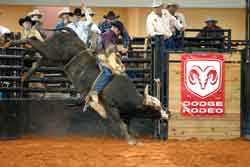 |
| Photo courtesy of Andrew Sullivan |
The Enumclaw Expo Center, on 72 acres in the shadow of Mt. Rainier, is the ideal facility to serve this equestrian-centric community, as well as events of nearly any kind. The Expo provides numerous options for any event, with two arenas (one covered), four barns, activity and exhibit halls, RV park and an 8,328 square foot historic field house, which neighbors a park, golf course, lodging and a 1,200-seat stadium.
Rodeo the Lone Star Way
If you're talking about rodeo, it would be a Texas-sized mistake to leave out the Lone Star State.
"We are very fortunate in Montgomery County to be set up perfectly for pro rodeos," says Harold Hutcheson, manager, Conroe Convention & Visitors Bureau. Hutcheson is referring to the Lone Star Convention and Expo Center and its state-of-the-art rodeo arena and equestrian center.
"Thanks to the Lone Star Center's covered arena, weather never gets in the way of your event, and if you're talking about a rodeo being successful just because of the people, Conroe is a great place," says Hutcheson. "The Montgomery County Rodeo drew record crowds this year, and all of our hotels were quite full."
"We're only a short drive north of Houston. Dallas is just up the freeway, and just an hour to the west is Bryan-College Station, so events in Conroe have access to a huge population that can come here easily," says Hutcheson.
An Iowa Institution
Each year on Labor Day weekend, an Iowa state tradition comes alive at the Dayton National Championship Rodeo.
"About 10,000 spectators come from all over for the four Labor Day Weekend performances," says Kerrie Kuiper, marketing director, Fort Dodge Convention and Visitors Bureau. "It's a very long-standing event, 74 years old, and it takes place in a wonderful facility. The seating is on a hillside, with the rodeo at the bottom. There's permanent seating and people also bring chairs and sit on the grass. It's really a unique rodeo."
The Dayton Rodeo is also a serious competition on the circuit. Sanctioned by the PRCA and with a $40,000 purse, the Dayton Rodeo draws a fierce field of competitors.
Fort Dodge host its own series of events from equestrian shows to rodeos at the Webster County Fairgrounds, a year-round facility with indoor and outdoor arenas. The Tuff-N-Nuff bull riding competition brings together more than 150 pro, amateur and youth cowboys, along with 2,500 spectators, for two nights of rough riding excitement.
Riding into the Florida Sunset
Florida is synonymous with a lot of things – sun, beaches, blockbuster amusement parks – but one of its oldest traditions is lesser known. The Sunshine State actually has one of the oldest ranching traditions in the U.S., and today, Florida is one of the top five beef-producing states east of the Mississippi River.
So it's no surprise that rodeo also has a stronghold in this coastal ranch country, and the Silver Spurs Rodeo in Kissimmee, Florida, is a long-standing example.
"We began in 1942, as a place for folks to get together, learn horsemanship skills and have fellowship," says Wendi Jeannin, marketing director, Silver Spurs Rodeo. "It started as a quadrille, which is a kind of square dance on horseback, and then the founders decided to have a rodeo to raise money for war bonds, and the rest is history."
Now the largest rodeo east of the Mississippi, the PRCA-sanctioned Silver Spurs Rodeo takes place twice a year: in February, in conjunction with the Osceola County Fair, and also in June.
Twenty-two thousand people show up each February for the Silver Spurs Rodeo, and another 10,000 each June. After 70 years, that's impressive for any event. And just like rodeo all over America, it just keeps getting bigger.

